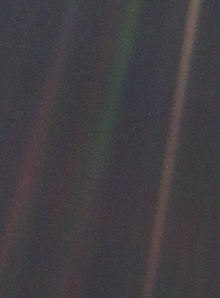A few crazy things to contemplate:http://voyager.jpl.nasa.gov/index.html

1) Voyager 1 is currently more than 10 billion miles away from the Earth. It took over 30 years for it to get that far, even traveling at crazy speeds (it's currently going about 38,000 miles an hour). Light travels the same distance in about 14 hours. At this rate, for a comparable spacecraft to go one lightyear would take over 17,000 years. And, the next nearest star to the sun is over 4 light years away. This just goes to show that practical interstellar space travel really is the stuff of science fiction for the time being. Check out the Voyager site at http://voyager.jpl.nasa.gov/index.html

2) Here's what the Earth looks like from millions of miles away. This picture was taken by Voyager 1 in 1990, and Carl Sagan dubbed it the "pale blue dot", and wrote a book about it. The bands across the image are sunlight interacting with the camera optics. The earth is the tiny blue dot you can barely see in the sunbeam on the right. More about this image can be found here.

3) If you were an alien, would you understand this? It's the cover on the "Golden Record" developed by Carl Sagan, meant to record significant sounds from the Earth in case extraterrestrial life ever discovers one of the Voyager spacecraft. The whole story of the Golden Record interesting as a time capsule of 1970s romanticism in science. The image comes from the Voyager site, here. A recent NPR radio program about Sagan and his wife and the Golden Record is found here. That NPR site has some great links, including some of the audio from the record itself.
No comments:
Post a Comment